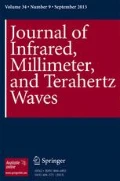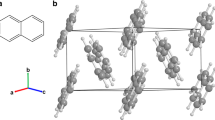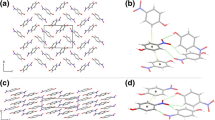Abstract
High-resolution and broadband THz spectra of the crystals of nine polycyclic aromatic hydrocarbons (PAHs) are presented. Five PAHs are comprised of ortho-fused benzene rings and the other four of peri-fused benzene rings. THz mode assignment is performed by using the anthracene and pyrene crystals as examples. The performance of the PBE functional augmented by Grimme’s two dispersion correction terms, D* and D3, respectively, are rigorously evaluated against the experimental criteria of frequency and isotope shift (IS). The D* and D3 terms use empirical and semi-classical approach for correcting the London-type dispersion interactions, respectively. The nature of each THz mode simulated by PBE-D* and that by PBE-D3 is quantitatively compared in terms of the percentage contributions of the intermolecular and the intramolecular vibrations to the vibrational energy. We find that the two methods have equivalent performance in reproducing the frequencies, ISs, and nature of THz modes of both the anthracene and pyrene crystals.





Similar content being viewed by others
References
B. M. Fischer, H. Helm, and P. U. Jepsen, Chemical recognition with broadband THz spectroscopy,. Proc. IEEE, 95, no. 8, pp. 1592–1604, 2007, https://doi.org/10.1109/jproc.2007.898904.
I. Hosako et al., At the dawn of a new era in terahertz technology,. Proc. IEEE, vol. 95, no. 8, pp. 1611–1623, 2007, https://doi.org/10.1109/jproc.2007.898844.
J. H. Son, Terahertz electromagnetic interactions with biological matter and their applications,. J. Appl. Phys., vol. 105, no. 10, 2009, Art no. 102033, https://doi.org/10.1063/1.3116140.
P. U. Jepsen, D. G. Cooke, and M. Koch, Terahertz spectroscopy and imaging - Modern techniques and applications,. Laser & Photonics Reviews, vol. 5, no. 1, pp. 124–166, 2011, https://doi.org/10.1002/lpor.201000011.
T. Nagatsuma, Terahertz technologies: present and future,. Ieice Electronics Express, vol. 8, no. 14, pp. 1127–1142, 2011, https://doi.org/10.1587/elex.8.1127.
Y. C. Shen, Terahertz pulsed spectroscopy and imaging for pharmaceutical applications: A review,. Int. J. Pharm., vol. 417, no. 1–2, pp. 48–60, 2011, https://doi.org/10.1016/j.ijpharm.2011.01.012.
R. M. Smith and M. A. Arnold, Terahertz Time-Domain Spectroscopy of Solid Samples: Principles, Applications, and Challenges,. Applied Spectroscopy Reviews, vol. 46, no. 8, pp. 636–679, 2011, https://doi.org/10.1080/05704928.2011.614305.
A. I. McIntosh, B. Yang, S. M. Goldup, M. Watkinson, and R. S. Donnan, Terahertz spectroscopy: a powerful new tool for the chemical sciences?,. Chem. Soc. Rev., vol. 41, no. 6, pp. 2072–2082, 2012, https://doi.org/10.1039/c1cs15277g.
A. Redo-Sanchez, N. Laman, B. Schulkin, and T. Tongue, Review of Terahertz Technology Readiness Assessment and Applications,. J Infrared Millim. Terahertz Waves, vol. 34, no. 9, pp. 500–518, Sep 2013, https://doi.org/10.1007/s10762-013-9998-y.
Y. Li, L. Xu, Q. Zhou, G. Xiong, Y. Shen, and X. Deng, A comparative evaluation of the activities of thiol group and hydroxyl group in low-frequency vibrations using terahertz spectroscopy and DFT calculations,. Spectrochimica Acta Part A: Molecular and Biomolecular Spectroscopy, vol. 214, pp. 246–251 2019 2019/05/05/, https://doi.org/10.1016/j.saa.2019.02.018.
C. A. Angell, K. L. Ngai, G. B. McKenna, P. F. McMillan, and S. W. Martin, Relaxation in glassforming liquids and amorphous solids,. J. Appl. Phys., vol. 88, no. 6, pp. 3113–3157, 2000, https://doi.org/10.1063/1.1286035.
U. Møller, D. G. Cooke, K. Tanaka, and P. U. Jepsen, Terahertz reflection spectroscopy of Debye relaxation in polar liquids, J. Opt. Soc. Am. B, vol. 26, no. 9, pp. A113-A125, 2009, https://doi.org/10.1364/JOSAB.26.00A113.
J. T. Kindt and C. A. Schmuttenmaer, Far-Infrared Dielectric Properties of Polar Liquids Probed by Femtosecond Terahertz Pulse Spectroscopy,. The Journal of Physical Chemistry, vol. 100, no. 24, pp. 10373–10379, 1996, https://doi.org/10.1021/jp960141g.
N. Yamamoto, K. Ohta, A. Tamura, and K. Tominaga, Broadband Dielectric Spectroscopy on Lysozyme in the Sub-Gigahertz to Terahertz Frequency Regions: Effects of Hydration and Thermal Excitation,. J. Phys. Chem. B, vol. 120, no. 21, pp. 4743–4755, 2016, https://doi.org/10.1021/acs.jpcb.6b01491.
N. Yamamoto et al., Effect of Temperature and Hydration Level on Purple Membrane Dynamics Studied Using Broadband Dielectric Spectroscopy from Sub-GHz to THz Regions, J. Phys. Chem. B, vol. 122, no. 4, pp. 1367–1377, Feb 2018, https://doi.org/10.1021/acs.jpcb.7b10077.
L. Berthier and G. Biroli, Theoretical perspective on the glass transition and amorphous materials,. Rev. Mod. Phys., vol. 83, no. 2, pp. 587–645, 2011. https://doi.org/10.1103/RevModPhys.83.587.
U. Buchenau, C. Schönfeld, D. Richter, T. Kanaya, K. Kaji, and R. Wehrmann, Neutron Scattering Study of the Vibration-Relaxation Crossover in Amorphous Polycarbonates,. Phys. Rev. Lett., vol. 73, no. 17, pp. 2344–2347, 1994, https://doi.org/10.1103/PhysRevLett.73.2344.
S. Kastner, M. Köhler, Y. Goncharov, P. Lunkenheimer, and A. Loidl, High-frequency dynamics of type B glass formers investigated by broadband dielectric spectroscopy,. J. Non-Cryst. Solids, vol. 357, no. 2, pp. 510–514, 2011, https://doi.org/10.1016/j.jnoncrysol.2010.06.074.
F. Zhang, H.-W. Wang, K. Tominaga, and M. Hayashi, Mixing of intermolecular and intramolecular vibrations in optical phonon modes: terahertz spectroscopy and solid-state density functional theory,. Wiley Interdisciplinary Reviews: Computational Molecular Science, vol. 6, no. 4, pp. 386–409, 2016, https://doi.org/10.1002/wcms.1256.
F. Zhang, H.-W. Wang, K. Tominaga, M. Hayashi, T. Hasunuma, and A. Kondo, Application of THz Vibrational Spectroscopy to Molecular Characterization and the Theoretical Fundamentals: An Illustration Using Saccharide Molecules,. Chemistry – An Asian Journal, vol. 12, no. 3, pp. 324–331, 2017, https://doi.org/10.1002/asia.201601419.
Y. Li, A. Lukacs, S. Bordacs, J. Moczar, M. Nyitrai, and J. Hebling, The effect of the flexibility of hydrogen bonding network on low-frequency motions of amino acids. Evidence from Terahertz spectroscopy and DFT calculations,. Spectrochimica Acta Part a-Molecular and Biomolecular Spectroscopy, vol. 191, pp. 8–15, 2018, https://doi.org/10.1016/j.saa.2017.09.035.
M. Born and K. Huang, Dynamical Theory of Crystal Lattice, Clarendon Press, Oxford Classic Texts in the Physical Science, 1998.
C. Kittel, Introduction to Solid State Physics, John Wiley & Sons, Inc, Press, Eighth Edition, 2004.
A. Togo and I. Tanaka, First principles phonon calculations in materials science,. Scripta Mater, vol. 108, pp. 1–5, 2015, https://doi.org/10.1016/j.scriptamat.2015.07.021.
J. Chen, L. Hu, J. Deng, and X. Xing, Negative thermal expansion in functional materials: controllable thermal expansion by chemical modifications,. Chem. Soc. Rev., vol. 44, no. 11, pp. 3522–3567, 2015, https://doi.org/10.1039/C4CS00461B.
W. Miller, C. W. Smith, D. S. Mackenzie, and K. E. Evans, Negative thermal expansion: a review,. Journal of Materials Science vol. 44, no. 20, pp. 5441–5451, 2009, https://doi.org/10.1007/s10853-009-3692-4.
Y. Z. Pei, X. Y. Shi, A. LaLonde, H. Wang, L. D. Chen, and G. J. Snyder, Convergence of electronic bands for high performance bulk thermoelectrics,. Nature, vol. 473, no. 7345, pp. 66–69, May 2011, https://doi.org/10.1038/nature09996.
T. M. Tritt and M. A. Subramanian, Thermoelectric materials, phenomena, and applications: A bird's eye view,. MRS Bull, vol. 31, no. 3, pp. 188–194, 2006, https://doi.org/10.1557/mrs2006.44.
B. Fultz, Vibrational thermodynamics of materials,. Prog. Mater Sci, vol. 55, no. 4, pp. 247–352, 2010, https://doi.org/10.1016/j.pmatsci.2009.05.002.
H. X. Ji et al., Enhanced thermal conductivity of phase change materials with ultrathin-graphite foams for thermal energy storage,. Energy & Environmental Science, vol. 7, no. 3, pp. 1185–1192, 2014, https://doi.org/10.1039/c3ee42573h.
R. Yang, X. Y. Wang, Y. Zhang, H. Y. Mao, P. Lan, and D. G. Zhou, Facile Synthesis of Mesoporous Silica Aerogels from Rice Straw Ash-based Biosilica via Freeze-drying,. Bioresources, vol. 14, no. 1, pp. 87–98, 2019, https://doi.org/10.15376/biores.14.1.87-98.
S. Califano and V. Schettino, Vibrational relaxation in molecular crystals,. Int. Rev. Phys. Chem, vol. 7, no. 1, pp. 19–57, 1988, https://doi.org/10.1080/01442358809353204.
P. G. Klemens, Anharmonic Decay of Optical Phonons, Phys. Rev, vol. 148, no. 2, pp. 845–848, 1966, https://doi.org/10.1103/PhysRev.148.845.
M. D. King, W. Ouellette, and T. M. Korter, Noncovalent Interactions in Paired DNA Nucleobases Investigated by Terahertz Spectroscopy and Solid-State Density Functional Theory, (in English). J. Phys. Chem. A, vol. 115, no. 34, pp. 9467–9478, 2011, https://doi.org/10.1021/Jp111878h.
F. Nishimura, H. Hoshina, Y. Ozaki, and H. Sato, Isothermal crystallization of poly (glycolic acid) studied by terahertz and infrared spectroscopy and SAXS/WAXD simultaneous measurements,. Polym. J, vol. 51, no. 2, pp. 237–245, 2019, https://doi.org/10.1038/s41428-018-0150-7.
M. T. Ruggiero, J. A. Zeitler, and A. Erba, Intermolecular anharmonicity in molecular crystals: interplay between experimental low-frequency dynamics and quantum quasi-harmonic simulations of solid purine,. Chem. Commun. vol. 53, no. 26, pp. 3781–3784, 2017, https://doi.org/10.1039/C7CC00509A.
F. Zhang, H.-W. Wang, K. Tominaga, M. Hayashi, S. Lee, and T. Nishino, Elucidation of Chiral Symmetry Breaking in a Racemic Polymer System with Terahertz Vibrational Spectroscopy and Crystal Orbital Density Functional Theory,. The Journal of Physical Chemistry Letters, vol. 7, no. 22, pp. 4671–4676, 2016 https://doi.org/10.1021/acs.jpclett.6b02213.
J. Neu, H. Nikonow, and C. A. Schmuttenmaer, Terahertz Spectroscopy and Density Functional Theory Calculations of dl-Norleucine and dl-Methionine,. J. Phys. Chem. A, vol. 122, no. 28, pp. 5978–5982, 2018 https://doi.org/10.1021/acs.jpca.8b04978.
F. Zhang et al., Terahertz spectroscopy and solid-state density functional theory calculation of anthracene: Effect of dispersion force on the vibrational modes, J. Chem. Phys., vol. 140, no. 17, p. 174509, 2014, https://doi.org/10.1063/1.4873421.
F. Zhang et al., Analysis of vibrational spectra of solid-state adenine and adenosine in the terahertz region,. RSC Adv. vol. 4, no. 1, pp. 269–278, 2014, https://doi.org/10.1039/C3RA44285C.
S. D. Costa et al., Resonant Raman spectroscopy on enriched C-13 carbon nanotubes,. Carbon, vol. 49, no. 14, pp. 4719–4723, 2011, https://doi.org/10.1016/j.carbon.2011.06.076.
T. Sasaki, T. Tanabe, and J. i. Nishizawa, 2016 Frequency accuracy and resolution of a GaP continuous-wave terahertz spectrometer, in 2016 41st International Conference on Infrared, Millimeter, and Terahertz waves (IRMMW-THz), pp. 1–2, https://doi.org/10.1109/IRMMW-THz.2016.7758380.
T. Sasaki, T. Sakamoto, and M. Otsuka, Detection of Impurities in Organic Crystals by High-Accuracy Terahertz Absorption Spectroscopy,. Anal. Chem, vol. 90, no. 3, pp. 1677–1682, 2018, https://doi.org/10.1021/acs.analchem.7b03220.
S. Grimme, J. Antony, S. Ehrlich, and H. Krieg, A consistent and accurate ab initio parametrization of density functional dispersion correction (DFT-D) for the 94 elements H-Pu,. J. Chem. Phys, vol. 132, no. 15, 2010, 154104, https://doi.org/10.1063/1.3382344.
R. Dovesi et al., CRYSTAL17 munual, University of Torino, Torino, 2017.
R. Dovesi, A. Erba, R. Orlando, C. M. Zicovich−Wilson, B. Civalleri, L. Maschio, M. Rérat, S. Casassa, J. Baima, S. Salustro, et al., Quantummechanical condensed matter simulations with CRYSTAL, vol. 8, no. 4, e1360, 2018, https://doi.org/10.1002/wcms.1360.
L. Maschio, B. Kirtman, R. Orlando, and M. Rèrat, Ab initio analytical infrared intensities for periodic systems through a coupled perturbed Hartree-Fock/Kohn-Sham method,. J. Chem. Phys., vol. 137, no. 20, p. 204113, 2012, https://doi.org/10.1063/1.4767438.
M. Ferrero, M. Rérat, B. Kirtman, and R. Dovesi, Calculation of first and second static hyperpolarizabilities of one- to three-dimensional periodic compounds. Implementation in the CRYSTAL code,. J. Chem. Phys., vol. 129, no. 24, p. 244110, 2008, https://doi.org/10.1063/1.3043366.
R. Dovesi et al., CRYSTAL14 User’s Manual. Torino: University of Torino, 2014.
J. P. Perdew, K. Burke, and M. Ernzerhof, Generalized Gradient Approximation Made Simple, Phys. Rev. Lett. vol. 77, no. 18, 3865-3868, 1996. https://doi.org/10.1103/PhysRevLett.77.3865.
R. Krishnan, J. S. Binkley, R. Seeger, and J. A. Pople, Self-consistent molecular orbital methods. XX. A basis set for correlated wave functions,. J. Chem. Phys., vol. 72, no. 1, pp. 650–654, 1980, https://doi.org/10.1063/1.438955.
S. Grimme, Semiempirical GGA-type density functional constructed with a long-range dispersion correction,. J. Comput. Chem, vol. 27, no. 15, pp. 1787–1799, 2006, https://doi.org/10.1002/jcc.20495.
S. Grimme, J. Antony, T. Schwabe, and C. Muck-Lichtenfeld, Density functional theory with dispersion corrections for supramolecular structures, aggregates, and complexes of (bio) organic molecules,. Organic & Biomolecular Chemistry, vol. 5, no. 5, pp. 741–758, 2007, https://doi.org/10.1039/b615319b.
C. Morgado, M. A. Vincent, I. H. Hillier, and X. Shan, Can the DFT-D method describe the full range of noncovalent interactions found in large biomolecules?,. PCCP, vol. 9, no. 4, pp. 448–451, 2007, https://doi.org/10.1039/b615263e.
T. van Mourik, Assessment of Density Functionals for Intramolecular Dispersion-Rich Interactions,. J. Chem. Theory Comput, vol. 4, no. 10, pp. 1610–1619, 2008, https://doi.org/10.1021/ct800231f.
Y. Bouteiller, J. C. Poully, C. Desfrancois, and G. Gregoire, Evaluation of MP2, DFT, and DFT-D Methods for the Prediction of Infrared Spectra of Peptides,. J. Phys. Chem. A, vol. 113, no. 22, pp. 6301–6307, 2009, https://doi.org/10.1021/jp901570r.
B. Civalleri, C. M. Zicovich-Wilson, L. Valenzano, and P. Ugliengo, B3LYP augmented with an empirical dispersion term (B3LYP-D*) as applied to molecular crystals,. Crystengcomm, vol. 10, no. 4, pp. 405–410, 2008, https://doi.org/10.1039/b715018k.
S. L. Chaplot, N. Lehner, and G. S. Pawley, THE STRUCTURE OF ANTHRACENE-D10 AT 16-K USING NEUTRON-DIFFRACTION,. Acta Crystallographica Section B-Structural Science, vol. 38, no. FEB, pp. 483–487, 1982, https://doi.org/10.1107/s0567740882003239.
Y. Kai, F. Hama, N. Yasuoka, and N. Kasai, Structural chemistry of layered cyclophanes. III. Molecular structures of [2.2](2,7)pyrenophane-1,1′-diene and pyrene (redetermined) at −160°C, Acta Crystallographica Section B, vol. 34, no. 4, pp. 1263–1270, 1978, https://doi.org/10.1107/s0567740878005312.
P. H. C. Eilers, 2003 A Perfect Smoother, . Anal. Chem., vol. 75, no. 14, pp. 3631–3636, https://doi.org/10.1021/ac034173t.
P. H. C. Eilers, Parametric Time Warping,. Anal. Chem, vol. 76, no. 2, pp. 404–411, 2004 https://doi.org/10.1021/ac034800e.
H. Houjou, Evaluation of coupling terms between intra- and intermolecular vibrations in coarse-grained normal-mode analysis: Does a stronger acid make a stiffer hydrogen bond?,. J. Chem. Phys., vol. 135, no. 15, p. 154111, 2011, https://doi.org/10.1063/1.3652102.
H. Houjou, Modelling intra- and intermolecular vibrations under the harmonic oscillator approximation: from symmetry-adapted to coarse-grained coordinate approaches,. J. Math. Chem vol. 55, no. 2, pp. 532–551, 2017, https://doi.org/10.1007/s10910-016-0692-x.
F. Zhang, K. Tominaga, M. Hayashi, and H.-W. Wang, 2014 Low-frequency vibration study of amino acids using terahertz spectroscopy and solid-state density functional theory, in Proc. SPIE 9275, Infrared, Millimeter-Wave, and Terahertz Technologies III, C.-L. Zhang. X.-C. Zhang. M. Tani, Ed., vol. 92750D, Beijing, , pp. 92750D-9. https://doi.org/10.1117/12.2071528
Acknowledgments
All the authors thank Dr. Kaoru Ohta for his illuminating discussions. A part of this research is based on the Cooperative Research Project of Research Center for Biomedical Engineering. The theoretical computations were performed using the Research Center for Computational Science, Okazaki, Japan.
Funding
F.Z. received support from the JSPS Grant-In-Aid project (18K05034). M.H. received financial support from the Ministry of Science and Technology (MOST) of Taiwan under MOST 107-2113-M-002-012.
Author information
Authors and Affiliations
Corresponding authors
Additional information
Publisher’s Note
Springer Nature remains neutral with regard to jurisdictional claims in published maps and institutional affiliations.
Electronic Supplementary Material
ESM 1
(DOCX 92 kb)
Rights and permissions
About this article
Cite this article
Zhang, F., Wang, HW., Tominaga, K. et al. High-Resolution THz Spectroscopy and Solid-State Density Functional Theory Calculations of Polycyclic Aromatic Hydrocarbons. J Infrared Milli Terahz Waves 41, 1378–1392 (2020). https://doi.org/10.1007/s10762-019-00621-0
Received:
Accepted:
Published:
Issue Date:
DOI: https://doi.org/10.1007/s10762-019-00621-0




